A Fourth-Order Block-Grid Method for Solving Laplace′s Equation on a Staircase Polygon with Boundary Functions in Ck,λ
Abstract
The integral representations of the solution around the vertices of the interior reentered angles (on the “singular” parts) are approximated by the composite midpoint rule when the boundary functions are from C4,λ, 0 < λ < 1. These approximations are connected with the 9-point approximation of Laplace′s equation on each rectangular grid on the “nonsingular” part of the polygon by the fourth-order gluing operator. It is proved that the uniform error is of order O(h4 + ε), where ε > 0 and h is the mesh step. For the p-order derivatives (p = 0,1, …) of the difference between the approximate and the exact solutions, in each “ singular” part order is obtained; here rj is the distance from the current point to the vertex in question and αjπ is the value of the interior angle of the jth vertex. Numerical results are given in the last section to support the theoretical results.
1. Introduction
In the last two decades, among different approaches to solve the elliptic boundary value problems with singularities, a special emphasis has been placed on the construction of combined methods, in which differential properties of the solution in different parts of the domain are used (see [1, 2], and references therein).
In [2–7], a new combined difference-analytical method, called the block-grid method (BGM), is proposed for the solution of the Laplace equation on polygons, when the boundary functions on the sides causing the singular vertices are given as algebraic polynomials of the arc length. In the BGM, the given polygon is covered by a finite number of overlapping sectors around the singular vertices (“singular” parts) and rectangles for the part of the polygon which lies at a positive distance from these vertices (“nonsingular” part). The special integral representation in each “singular” part is approximated, and they are connected by the appropriate order gluing operator with the finite difference equations used in the “nonsingular” part of the polygon.
In [8, 9], the restriction on the boundary functions to be algebraic polynomials on the sides of the polygon causing the singular vertices in the BGM was removed. It was assumed that the boundary function on each side of the polygon is given from the Hölder classes Ck,λ, 0 < λ < 1, and on the “nonsingular” part the 5-point scheme is used when k = 2 [8] and the 9-point scheme is used when k = 6 [9]. For the 5-point scheme a simple linear interpolation with 4 points is used. For the 9-point scheme an interpolation with 31 points is used to construct a gluing operator connecting the subsystems. Moreover, to connect the quadrature nodes which are at a distance of less than 4h from boundary of the polygon, a special representation of the harmonic function through the integrals of Poisson type for a half plane is used (see [9]).
In this paper the BGM is developed for the Dirichlet problem when the boundary function on each side of the polygon is from C4,λ, by using the 9-point scheme on the “nonsingular” part with 16-point gluing operator for all quadrature nodes, including those near the boundary. The paper is organized as follows: in Section 2, the boundary value problem and the integral representations of the exact solution in each “singular” part are given. In Section 3, to support the aim of the paper, a Dirichlet problem on the rectangle for the known exact solution from Ck,λ, k = 3,4, is solved using the 9-point scheme and the numerical results are illustrated. In Section 4, the system of block-grid equations and the convergence theorems are given. In Section 5 a highly accurate approximation of the coefficient of the leading singular term of the exact solution (stress intensity factor) is given. In Section 6 the method is illustrated for solving the problem in L-shaped polygon with the corner singularity. The conclusions are summarized in Section 7.
2. Dirichlet Problem on a Staircase Polygon
Let G be an open simply connected polygon, γj, j = 1,2, …, N, its sides, including the ends, enumerated counterclockwise, γ = γ1 ∪ ⋯∪γN the boundary of G, and αjπ, (αj = 1/2, 1, 3/2, 2), the interior angle formed by the sides γj−1 and γj, (γ0 = γN). Denote by Aj = γj−1∩γj the vertex of the jth angle and by rj, θj a polar system of coordinates with a pole in Aj, where the angle θj is taken counterclockwise from the side γj.
where Δ ≡ ∂2/∂x2 + ∂2/∂y2, φj is a given function on γj of the arc length s taken along γ, and φj ∈ C4,λ(γj), 0 < λ < 1; that is, φj has the fourth-order derivative on γj, which satisfies a Hölder condition with exponent λ.
are fulfilled. For the remaining vertices Aj, the values of φj−1 and φj at Aj might be different. Let E be the set of all j, (1 ≤ j ≤ N) for which αj ≠ 1/2 or αj = 1/2, but (2) is not fulfilled. In the neighborhood of Aj, j ∈ E, we construct two fixed block sectors , where 0 < rj2 < rj1 < min {sj+1 − sj, sj − sj−1}, Tj(r) = {(rj, θj) : 0 < rj < r, 0 < θj < αjπ}.
The function Qj(rj, θj) is harmonic on and satisfies the boundary conditions in (1) on and , j ∈ E, except for the point Aj when φj−1(sj) ≠ φj(sj).
We formally set the value of Qj(rj, θj) and the solution u of the problem (1) at the vertex Aj equal to (φj−1(sj) + φj(sj))/2, j ∈ E.
3. 9-Point Solution on Rectangles
Let Π = {(x, y) : 0 < x < a, 0 < y < b} be a rectangle, with a/b being rational, γj, j = 1,2, 3,4 the sides, including the ends, enumerated counterclockwise, starting from the left side (γ0 ≡ γ4, γ5 ≡ γ1), and the boundary of Π.
where φj is the given function on γj.
Definition 2. One says that the solution u of the problem (9) belongs to if
Remark 3. From Theorem 3.1 in [11] it follows that the class of functions is wider than .
On the basis of the maximum principle the unique solvability of the system of finite difference equations (13) follows (see [12, Chapter 4]).
Everywhere below we will denote constants which are independent of h and of the cofactors on their right by c, c0, c1, …, generally using the same notation for different constants for simplicity.
Theorem 4. Let u be the solution of problem (9). If , then
where uh is the solution of the system (13).
Proof. For the proof of this theorem see [13].
where , is the exact solution of this problem, which is from .
We solve the problem (16) by approximating 9-point scheme when k = 3,4 for the different values of λ.
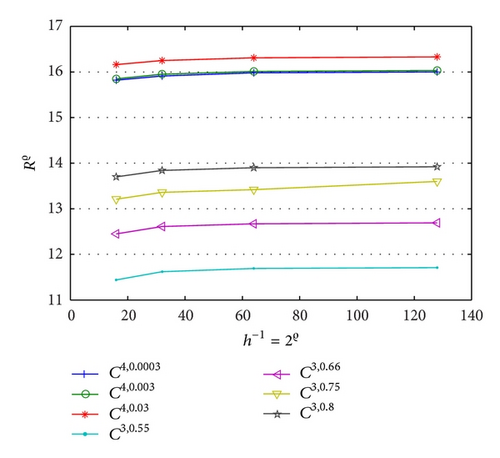
4. System of Block-Grid Equations
In addition to the sectors and (see Section 2) in the neighborhood of each vertex Aj, j ∈ E of the polygon G, we construct two more sectors and , where 0 < rj4 < rj3 < rj2, rj3 = (rj2 + rj4)/2 and , k ≠ l, k, l ∈ E, and let .
We cover the given solution domain (a staircase polygon) by the finite number of sectors , and rectangles Πk ⊂ GT, k = 1,2, …, M, as is shown in Figure 2, for the case of L-shaped polygon, where j = 1, M = 4 (see also [2]). It is assumed that for the sides a1k and a2k of Πk the quotient a1k/a2k is rational and . Let ηk be the boundary of the rectangle Πk, let Vj be the curvilinear part of the boundary of the sector , and let . We choose a natural number n and define the quantities n(j) = max {4, [αjn]}, βj = αjπ/n(j), and . On the arc Vj we take the points , and denote the set of these points by . We introduce the parameter h ∈ (0, ϰ0/4], where ϰ0 is a gluing depth of the rectangles Πk, k = 1,2, …, M, and define a square grid on Πk, k = 1,2, …, M, with maximal possible step hk ≤ min {h, min {a1k, a2k}/6} such that the boundary ηk lies entirely on the grid lines. Let be the set of grid nodes on Πk, let be the set of nodes on ηk, and let . We denote the set of nodes on the closure of ηk∩GT by , the set of nodes on tkj by , and the set of remaining nodes on ηk by .
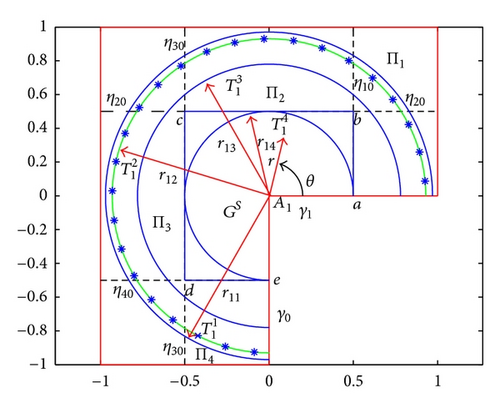
and sP corresponds to such a point Q ∈ γm for which the line PQ is perpendicular to γm.
where j ∈ E, 1 ≤ q ≤ n(j), and c1, c2 are constants independent of ε.
where 1 ≤ k ≤ M, 1 ≤ m ≤ N, and j ∈ E.
Theorem 6. There is a natural number n0, such that for all n ≥ n0 and for any ε > 0 the system (26) has a unique solution.
Proof. From the estimation (2.29) in [15] follows the existence of the positive constants n0 and σ, such that for all n ≥ n0
Theorem 7. There exists a natural number n0, such that for all
Proof. Let
On the basis of estimations (15), (21), (25), and Lemma 1 by analogy to the proof of Theorem 4.3 in [9] the proof of inequality (30) follows.
The function given by formula (27), defined on the closed sector , where , and the integral representation (8) of the exact solution of the problem (1) is given on , j ∈ E, and then the difference function is defined on , j ∈ E and
5. Stress Intensity Factor
where {·} is the symbol of fractional part. These conditions for the given αj can be fulfilled by decreasing λ.
6. Numerical Results
where Ω = {(x, y) : 0 ≤ x ≤ 1, − 1 ≤ y ≤ 0} and γ is the boundary of G.
is the exact solution of this problem.
where Ω1 = {(x, y) : 0 ≤ x ≤ 0.5, − 0.5 ≤ y ≤ 0}. Then GNS = G∖GS is a “nonsingular” part of G.
where and . Since we have only one singular point, we omit subindices in (51). We calculate the values Qε(r12, θq) and Qε(r, θ) on the grids , with an accuracy of ε using the quadrature formulae proposed in [10].
| (2−ϱ , n) | ||
|---|---|---|
| (2−4, 60) | 1.609 × 10−8 | 15.577 |
| (2−5, 170) | 1.033 × 10−9 | |
| (2−5, 130) | 1.191 × 10−9 | 16.690 |
| (2−6, 150) | 7.136 × 10−11 | |
| (2−5, 140) | 1.136 × 10−9 | 16.259 |
| (2−6, 170) | 6.991 × 10−11 | |
| (2−6, 100) | 2.169 × 10−10 | 17.096 |
| (2−7, 130) | 1.269 × 10−11 | |
| (2−ϱ, n) | ||
|---|---|---|
| (2−4, 100) | 1.931 × 10−8 | 16.078 |
| (2−5, 150) | 1.182 × 10−9 | |
| (2−5, 130) | 1.294 × 10−9 | 16.789 |
| (2−6, 150) | 7.708 × 10−11 | |
| (2−5, 140) | 1.312 × 10−9 | 17.967 |
| (2−6, 170) | 7.304 × 10−11 | |
| (2−6, 100) | 2.389 × 10−10 | 18.164 |
| (2−7, 130) | 1.315 × 10−11 | |
| (h−1, n) | Iteration | ||
|---|---|---|---|
| (16,70) | 1.139 × 10−8 | 1.572 × 10−8 | 22 |
| (32,170) | 1.033 × 10−9 | 1.184 × 10−9 | 23 |
| (64,170) | 6.990 × 10−11 | 7.304 × 10−11 | 24 |
| (128,200) | 8.628 × 10−12 | 8.833 × 10−12 | 25 |
| (h−1, n) | ||
|---|---|---|
| (16,70) | 3.895 × 10−7 | 3.895 × 10−7 |
| (32,170) | 4.627 × 10−8 | 4.627 × 10−8 |
| (64,170) | 1.124 × 10−9 | 3.125 × 10−9 |
| (128,200) | 2.214 × 10−10 | 2.233 × 10−10 |
in the “singular” parts of G, respectively, for ε = 5 × 10−13, where ϱ is a positive integer. In Table 3, the minimal values over the pairs (h−1, n) of the errors in maximum norm, of the approximate solution when ε = 5 × 10−13, are presented. The similar values of errors for the first-order derivatives are presented in Table 4, when ∂Q/∂x and ∂Q/∂y are approximated by fourth-order central difference formula on GS for r ≥ 0.2. For r < 0.2, the order of errors decreases down to 10−6, which are presented in Table 5. This happens because the integrands in (51) are not sufficiently smooth for fourth-order differentiation formula. The order of accuracy of the derivatives for r < 0.2 can be increased if we use similar quadrature rules, which we used for the integrals in (51) for the derivatives of integrands also.
| (h−1, n) | ||
|---|---|---|
| (16,70) | 9.663 × 10−6 | 9.663 × 10−6 |
| (32,170) | 9.653 × 10−6 | 9.653 × 10−6 |
| (64,170) | 9.649 × 10−6 | 9.649 × 10−6 |
| (128,200) | 9.648 × 10−6 | 9.648 × 10−6 |
| h−1 | |||
|---|---|---|---|
| 16 | 1.000000014856688 | 1.000000017180415 | 1.000000017197438 |
| 32 | 1.000000005800844 | 1.000000001230267 | 1.000000001236709 |
| 64 | 1.000000004138169 | 1.000000000073107 | 1.000000000079938 |
| 128 | 1.000000004053153 | 1.000000000003531 | 1.000000000003267 |
Figures 3 and 4 show the dependence on ε for different mesh steps h. Figure 5 demonstrates the convergence of the BGM with respect to the number of quadrature nodes for different mesh steps h. The approximate solution and the exact solution in the “singular” part are given in Figure 6, to illustrate the accuracy of the BGM. The error of the block-grid solution, when the function Q(r, θ) in (51) is calculated with an accuracy of ε = 5 × 10−13, is presented in Figure 7. Figures 8 and 9 show the singular behaviour of the first-order partial derivatives in the “singular” part. The ratios and , when ϱ = 5 with respect to different n values for h−1 = 64 and for a fixed value of n of h−1 = 32, are illustrated in Figures 10 and 11, respectively. These ratios show that the order of the convergence in both the “singular” and the “nonsingular” parts is asymptotically equal to 16 when n is kept fixed for h−1 = 32, and it is selected as large as possible (n > 100) for h−1 = 64.
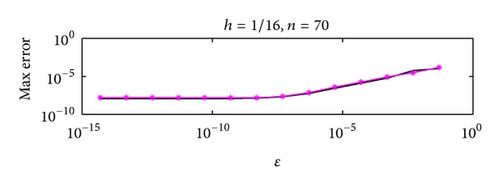
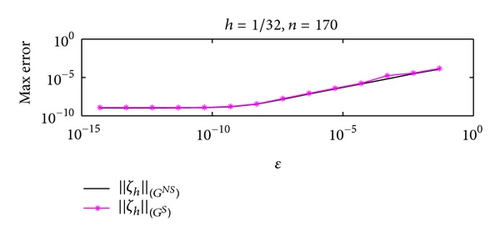
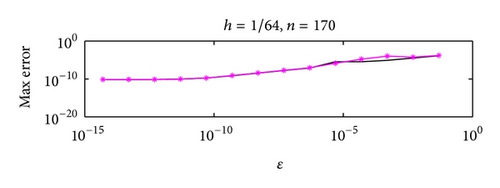
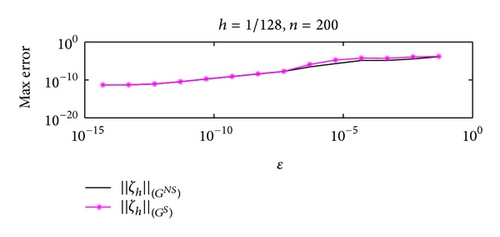
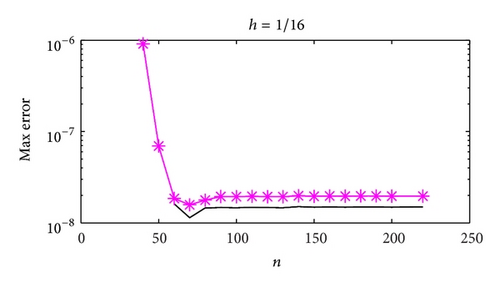
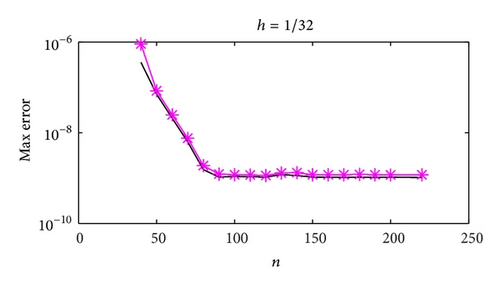

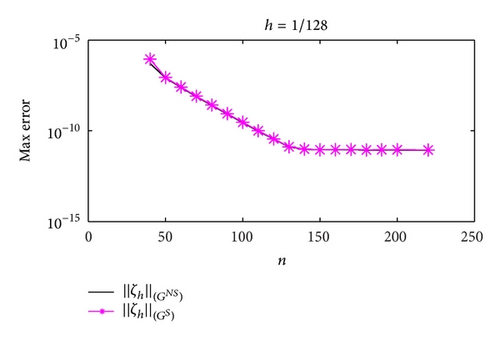

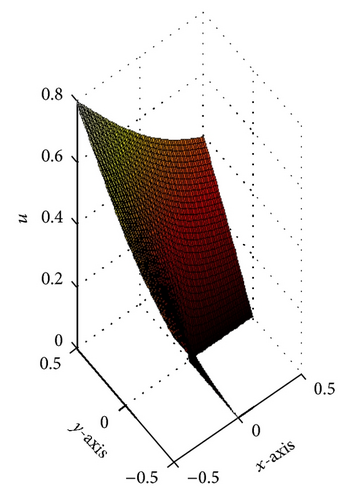
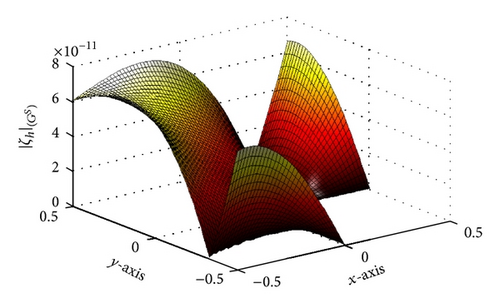
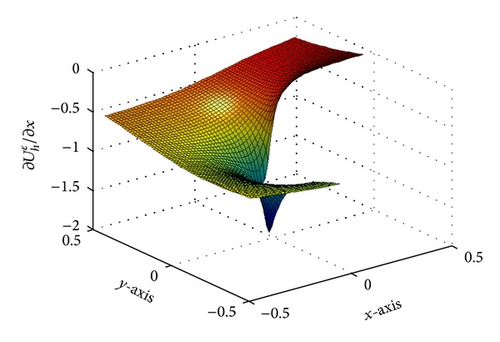
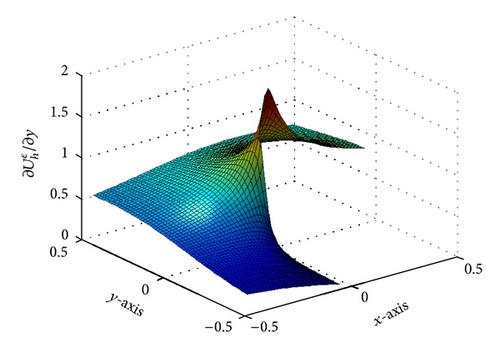
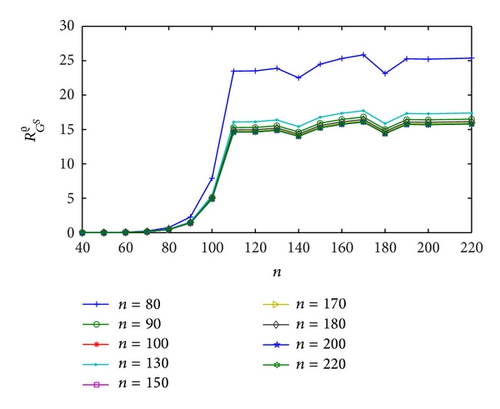
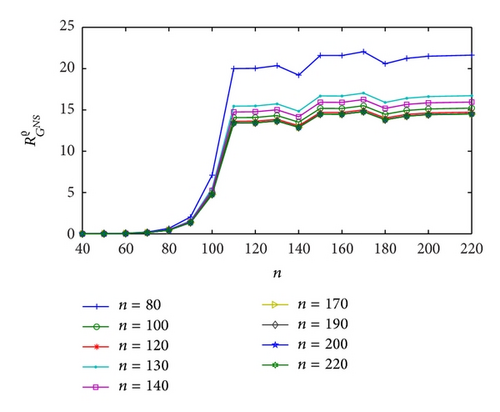
7. Conclusions
In the block-grid method (BGM) for solving Laplace′s equation, the restriction on the boundary functions to be algebraic polynomials on the sides of the polygon causing the singular vertices is removed. This condition is replaced by the functions from the Hölder classes C4,λ, 0 < λ < 1. In the integral representations around singular vertices (on the “singular” part), which are combined with the 9-point finite difference equations on the “nonsingular” part of the polygon, the boundary conditions are taken into account with the help of integrals of Poisson type for a half-plane. To connect the subsystems, a homogeneous fourth-order gluing operator is used. It is proved that the final uniform error is of order O(h4 + ε), where ε is the error of the approximation of the mentioned integrals and h is the mesh step. For the p-order derivatives (p = 0,1, …) of the difference between the approximate and the exact solutions, in each “singular” part order is obtained. The method is illustrated in solving the problem in L-shaped polygon with the corner singularity. Dependence of the approximate solution and its errors on ε, h and the number of quadrature nodes n are demonstrated. Furthermore, by the constructed approximate solution on the “singular” part of the polygon, a highly accurate formula for the stress intensity factor is given.
From the error estimation formula (33) of Theorem 7 it follows that the error of the approximate solution on the block sectors decreases as , which gives an additional accuracy of the BGM near the singular points.
The method and results of this paper are valid for multiply connected polygons.




